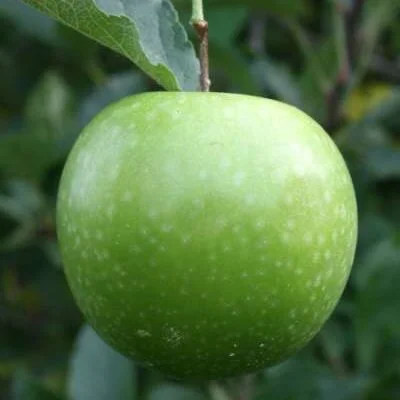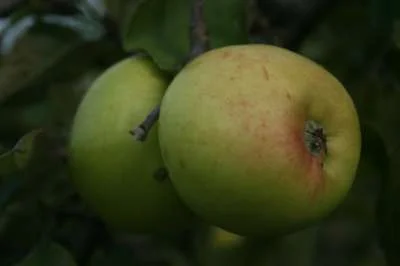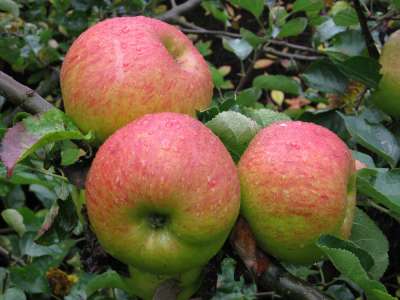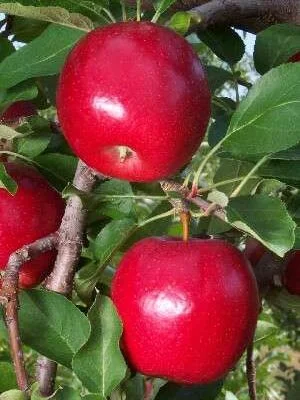Your basket is currently empty!
This is a celebration of the long and varied history of apple tree cultivation, apple varieties that may no longer be at the forefront of commercial horticulture – if they ever were – but which will reward the more discerning gardener with a rich and diverse range of tantalising flavour entirely lacking in todays homogenised commercial apple market. The apples you will find in supermarkets today bear little resemblance in flavour to these luminaries and to try them will educate and delight with a diverse and amazingly varied palette of taste you may never have known existed. They may not be the greatest of croppers, and some of them may need just that little bit of extra care to bring out their best, but even if you include just one or two of these in your planting programme you will be rewarded tenfold with some exquisite flavour characteristics, and absolutely none of them deserve o be consigned to horticultural oblivion.
Listed in no particular order of preference.
Cornish Gilliflower
A lovely old sort found in a Cottage Garden in Truro in the 1800’s no less, very little seen today. Not the most handsome of apples, the characteristically uneven exterior conceals a flavour delight. It can be eaten from late October and will store until February. At first the taste is richly aromatic and Cox like but later the yellow flesh develops a sweeter noticeably floral bouquet almost like no other. It is a light cropper which makes each fruit even more more-ish, a hardy enough tree but a warmer spot will bring about better cropping, which it fully deserves. The flower buds are a darkish mauve in colour.
Nutmeg Pippin
First known in 1920 so has stood the test of time! Although quite a small apple it is most attractive with golden fruits handsomely speckled with amber gold russet. The firm flesh is richly aromatic with hints of nutmeg – tantalising! Best harvested late in October and stored for use from Christmas onwards. The tree is upright and slightly spreading; a wonderful table apple.
Worcester Pearmain
Not particularly unusual and a popular garden apple through the years but deserves a mention here. Once a popular commercial variety too it has largely disappeared from shops but if you remember it you probably don’t know what you are missing for these samples were invariably harvested too early before the flavour has had a chance to develop. When properly fit the flesh softens, becomes exceedingly juicy and develops a distinct taste of summer raspberry. Pick and eat straight from the tree when properly ripe, it’s beautiful. A heavily red flushed apple for use mid September onwards, it is a tip bearer which although it can be grown as a cordon or espalier, is perhaps best as a bush tree.
Worcester 1873.
Lemon Pippin
Probably originating in France in the 19th C but popular on markets in London briefly. This unique culinary variety is well worth growing for the medium to large pale yellow fruits have a distinct aroma of lemons when properly fit and this is especially pronounced when the fruit has developed in warmer summers. Recommended for apple tarts, sweetmeats and for baking, can also be eaten fresh later in it’s season which is October to February or sometimes later with good storing. Somewhat more interesting than the ubiquitous Bramley Seedling!
Ashmeads Kernel
If you love russet apples then you will be considerably enamoured with this variety. Although believed to have been raised in the 1700’s it was the 1900’s before this variety achieved any form of popularity. Never accepted commercially because of light crops and what was considered poor colour, the magnificent flavour compensates in some style. A relatively large russet type the rich flavour develops distinct hints of fruit-drop. Densely textured. Season October-December.
American Mother
Massachusetts 1844 and popular for years in the USA as a cooker predominantly for pies. In this country it suits dual purpose, very valuable in the kitchen but with it’s complex flavour an eating sensation for dessert use too. Tender flesh has a difficult to describe flavour that must be tried – various authorities identify hints of vanilla, a balsamic sweetness, or distinct taste of pear drops. Whatever your opinion this one is not to be missed. Season Sept-November. Cropping can be erratic but well woth ignoring it’s idiosyncrasies.
William Crump
Possibly raised in Worcester and possibly not as there was considerable confusion – and competitive dispute – surrounding it’s introduction. What we d know is that William Crump is a Cox and Worcester cross and it’s two luminary parents did not disappoint. Best eaten in November when the rich firm flesh has a distinctly pineapple flavour. Later in season it becomes more akin to a Cox. A good garden variety which usually crops well and does well on all rootstocks and growing forms.
Rivers Early Peach
An old Hertfordshire variety raised by Thomas Rivers in 1893, this early eater truly does have a distinct peach-like taste in the first half of August. A boldly coloured apple strongly flushed red, it is very sweet with little to no acidity. Good cropper, and a delight so early in the season.
Laxtons Superb
A variety with a long and esteemed history as a garden apple but never popular commercially, regarded as a variety that will do well where Cox does not. Has some of the richness and complexity of Cox in it’s flavour, but sweeter too. Juicy and finely textured, very, very pleasurable to eat and handsome too with it’s deep purple red flush and stripes. Ready for picking early October and at it’s best eaten by Christmas, making a well branched easily trained tree. Bedford raised around 1897.
Fall Russet
A lovely little apple and a joy to have a true russet so early in the season, very intense flavour and firm texture, distinctly Cox like, the smallish fruits are richly coloured amber russet throughout and can be enjoyed from early September. Although the fruit is small it is a heavy cropper. A very old variety from the late 1800’s which was rediscovered in the 1950’s. A valuable garden tree to have.
Holstein
Incredibly flavour infact regarded by many aficionados has having even more flavour than Cox which it resembles but with an even deeper richer flavour, the fruit is very large – considerably bigger than a standard Cox – and becomes ripe from late September storing for several weeks. Perhaps not a variety for the beginner, being a triploid it is vigorous but rather disease prone, but when well grown produces superb fruit with a flavour to entice. German origin, early 1900’s.
Red Ellisons Orange
Lincolnshire raised receiving an RHS award of merit as far back as 1917. Something different again within the varies apple taste palette, harvested fruits develop a distinct hint of aniseed. The interior is crisp yet yielding and very juicy. Highly recommended to the connoisseur, this is a good garden variety with heavy crops of mostly moderate size fruit, we prefer Red Ellisons because of the higher colour on the skin; a hardy variety for use mid-late September and into October.
Saint Cecilia
Another for Cox fanatics with a superb rich and sweetly aromatic flavour within the Cox type, nicd crisp flesh, the fruit has a bold crimson flush over a green yellow background and often just a little russet. Best harvested not before mid October to allow the flavour to develop fully and will then keep until after the new year. A good cropper, raised in 1900 and introduced from Wales.
Irish Peach
Definitely one of the best flavoured earlies which gets the new apple season off to a great start. You can enjoy Irish Peach straight from the tree in the middle of August and savour the perfectly balanced flavour of sweet sugar and acidity at it’s best, often develops a slight floral bouquet adding an extra dimension to this fine dessert apple. The fruits are attractively brightly coloured and it crops well although being a tip bearer is better suited to bush growing.
Alkmene
A variety with many good garden characteristics but never popular and deserving f greater recognition. A predominantly gold and orange flushed apple which ripens from late September in the Cox style but better and easier to grow. The taste is richly honeyed, complex and addictive. It will keep a few weeks in store, the has good general disease resistance and is frost hardy, Popular in Germany and other parts of Europe. Well worth trying; good blossom.
Yellow Ingestrey
A strikingly beautiful garden tree with it’s distinctive semi weeping and pendulous branches bedecked with shapely clear yellow fruits. A wonderful lawn tree and productive with a multitude of fruits which have very good eating qualities – imbued with an intensely fruity taste – but which also make very good lasting table decoration. In years gone by sprigs and small branches were even used as celebratory decoration. Season early September to October; Shropshire raised in the 18th Century.
Kerry Pippin
Another strikingly beautiful apple with a skin finish mottled and decorated in light tawny orange, has been likened to that of a Tortoiseshell butterfly. Irish raised as to be expected from the name, introduced in 1802. The flavour is superb – rich and fruity with plenty of sweetness and balancing acidity. To be enjoyed from late August and through September making a productive upright tree. Well worth growing.
St Edmunds Pippin
Also known as St Edmunds Russet. Another for russet fans and a little different again, when properly ripe developing strong hints of vanilla and pear but with the unmistakeable nutty aromatic base quality of a true russet. The fruits can be quite large and a lightly bronze russeted over an olive green background; fruits over have a slight silvery sheen. Never popular commercially because the fruit does not travel well but this is hardly an issue for home gardeners who will be rewarded with fruits of ambrosial quality. Early flowering and in season from late September and throughout October. Bury St Edmunds 1875 early flowering.
Margaret
Highly valuable as the first dessert apple to ripen in early summer, frequently ready in July. Gaily coloured in scarlet with characteristically soft juicy flesh, flavour is not overly sweet or cloying with a refreshing taste, eat straight from the tree to enjoy at it’s best. A variety of considerable antiquity believed to have arisen in the 1600’s. Makes a neat upright tree especially good on smaller rootstocks.
Sunset
A Cox’s orange Pippin seedling but easier to grow and has achieved garden popularity but never commercially grown as the fruit is not large enough. Nicely coloured ith orange red stripes and flushing over a gold base, flavour briskly, intensely aromatic and with good texture. Eating qualities never disappoint. Season is the same as Cox, late September through October. An ideal garden apple which fully deserves it’s entry here.
Ways to grow
You might think that these older heirloom varieties are better suited, or more appropriate in a traditional orchard setting but the majority of these are perfectly compatible with more modern growing systems and rootstocks developed for todays smaller gardens.
Here’s an abbreviated run down that might give you ideas on how to incorporate one or two of these in your own space starting with the biggest trees.
Rootstock M25
Is a supe sized big tree for wide open spaces more than capable of reaching a height in excess of 20’plus. That’s a lot of tree! A lot of the fruit is out of reach and although fast growing it takes longer to come into bearing so this stock isn’t really recommended.
Rootstock M106
More traditionally orchard size, making 12-14’ and the same across. More tolerant of poorish soils.
Rootstock M26
Is a good compromise between the genuinely dwarfing trees and the larger more vigorous. Growing 10’ or so with the same spread.
Rootstock M9
Dwarfing, good for smaller gardens or a small lawn. Needs good soil to do well but crops heavily and early in life. Ultimate size around 8’ and the same across.
Rootstock M27
The smallest bush rootstock, truly miniature at just 6-7’ So easy to pick, suitable for pots and borders. Likes good hearty soil.
Against walls and fences
As espalier or fan; allow 2metres width and the same height for each tree. South or west is the best facing aspect but make sure the soil isn’t too dry.
Cordons and columns
Make use of the vertical accent in your garden with these ideal straight up and down non spreading trees which can be planted just 2.5’ apart individually or in a line. Cordons can be grown at an angle or against a wall, columns are more self supporting in any aspect that isn’t too open to wind and best grown upright. Columns are also ideal for container growing so you can fit one or two of these wonderful old varieties into almost any space.






